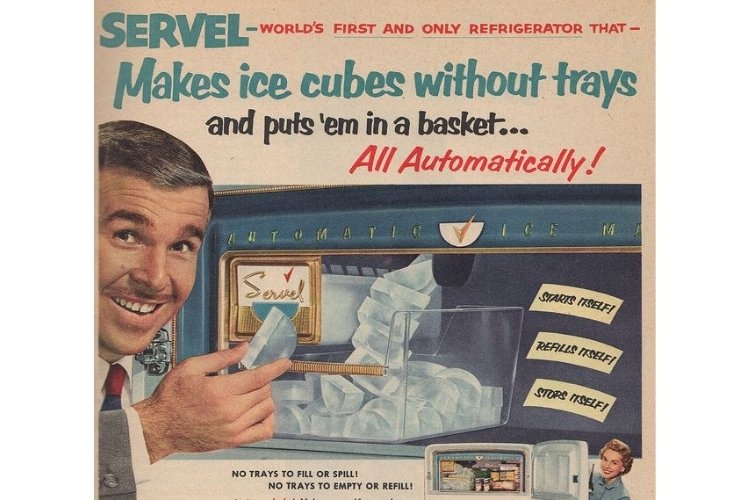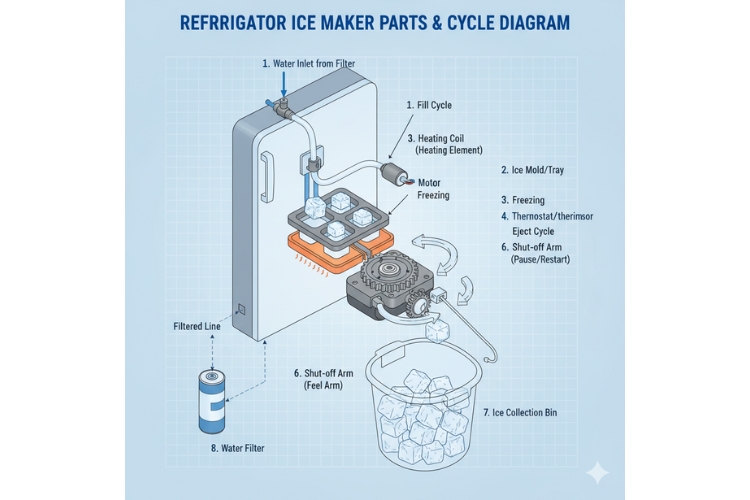A full, detailed explanation of refrigerator ice makers: their history, components, working process, troubleshooting, maintenance, and energy efficiency tips.
Introduction
Have you ever opened your freezer, scooped out a handful of ice cubes, and wondered: how does an ice maker on a fridge work? This question may seem simple, but the answer reveals a fascinating combination of engineering, refrigeration science, and user convenience. Ice makers have become a common household feature, transforming how we cool our drinks, preserve food, and entertain guests.
Understanding how these machines work not only satisfies curiosity but also helps you troubleshoot problems, improve energy efficiency, and extend the life of your refrigerator. In this article, we’ll break down the step-by-step process of how an ice maker works, explore its main components, common issues, and tips for maintenance—all while answering the core question: how does an ice maker on a fridge work?
The Evolution of Ice Makers
Before automatic ice makers, people had to fill trays with water and wait hours for them to freeze. This was inconvenient, especially for families or hosts who needed large amounts of ice quickly. In the mid-20th century, refrigerators with built-in ice makers revolutionized kitchens by automating this task. Today, many models even include dispensers for crushed ice, cubes, or even filtered water.
This background helps us appreciate why understanding how does an ice maker on a fridge work is more than trivia—it connects to how far home technology has advanced.

Key Components of a Fridge Ice Maker
To answer the question in detail, we need to look at the major components that make the system function:
- Water Supply Line: A small tube connects the refrigerator to your home’s water supply. This provides the ice maker with a steady source of water.
- Water Inlet Valve: An electrically controlled valve regulates when and how much water flows into the ice mold.
- Ice Mold (Tray): A metal or plastic mold where water freezes into cube shapes.
- Thermostat or Temperature Sensor: Detects when the water has frozen solid and signals the system to begin the harvest cycle.
- Heater Strip: A small heating element warms the bottom of the mold slightly so cubes can be released without sticking.
- Ejector Arm or Motorized Blades: Pushes the frozen cubes out of the mold into the storage bin.
- Storage Bin: Holds the ice cubes until they are needed.
- Control Module: Acts as the brain of the ice maker, coordinating the water fill, freezing, and cube release cycles.
Each of these parts works in harmony to ensure you get consistent ice production.

Step-by-Step Process: How Does an Ice Maker on a Fridge Work?
Let’s walk through the cycle from start to finish:
- Water Fill: When the ice maker senses it’s time to make ice, the control module activates the water inlet valve. This valve opens briefly, usually for about 7–10 seconds, allowing just the right amount of water to flow into the mold.
- Freezing Stage: The refrigerator’s freezer keeps the water in the mold at sub-zero temperatures. Over the next 60–90 minutes, the water solidifies into cubes.
- Detection by Thermostat: A thermostat or sensor inside the ice maker detects when the cubes have reached the ideal frozen state.
- Mold Heating: The heating strip underneath the mold briefly warms, loosening the cubes without melting them.
- Ejection Cycle: The ejector arm sweeps through the mold, pushing the cubes into the storage bin. If the bin is full, a sensor or mechanical arm stops the ice-making process until space is available again.
- Repeat Cycle: Once cubes are harvested, the cycle resets, and the ice maker waits for the right conditions to begin again.
This automated process is why ice makers are so convenient—you rarely need to intervene, aside from occasional maintenance.
Types of Fridge Ice Makers
While the basic process is similar, there are a few variations worth noting:
- Modular Ice Makers: Common in many standard refrigerators. These use a motorized ejector arm.
- Flex Tray Ice Makers: Use a flexible plastic mold that twists slightly to release ice.
- Dual Ice Makers: Found in high-end fridges, producing ice in both the freezer and the door.
- Crushed Ice and Cube Models: Equipped with blades that crush cubes before dispensing.
Knowing which type you own helps you understand specific troubleshooting needs.
Common Issues and Troubleshooting
Even the best ice makers encounter problems. Here are a few common issues and what they may indicate:
- No Ice Production: Possible causes: clogged water filter, blocked supply line, or defective inlet valve.
- Small or Misshapen Cubes: Usually caused by low water pressure or mineral buildup.
- Ice Tastes or Smells Bad: Likely due to dirty water filters or mold inside the ice bin.
- Ice Maker Leaks: A damaged water line or faulty valve may be the culprit.
Understanding how does an ice maker on a fridge work allows you to diagnose these problems more effectively.
Maintenance Tips for Longevity
Here are practical ways to keep your ice maker running smoothly:
- Replace Water Filters Regularly (every 6 months, or as recommended).
- Clean the Ice Bin to prevent odor and bacterial growth.
- Inspect the Water Line for kinks or leaks.
- Defrost the Freezer if ice buildup interferes with operation.
- Check the Shut-Off Arm to ensure it’s not stuck in the “off” position.
A little maintenance goes a long way in ensuring consistent ice production.
Energy Efficiency Considerations
Ice makers, while convenient, do consume additional energy. According to the U.S. Department of Energy, automatic ice makers can increase a refrigerator’s energy use by 12–20%. To minimize this impact:
- Opt for energy-efficient refrigerator models.
- Turn off the ice maker when you don’t need ice.
- Keep the freezer at the recommended 0°F (-18°C) for efficiency.
Being aware of energy consumption adds another dimension to understanding how does an ice maker on a fridge work.
Fun Facts About Ice Makers
- The average ice maker produces 3–7 pounds of ice per day.
- Some modern fridges use smart sensors that let you control ice production via smartphone apps.
- Hotels and restaurants use industrial ice machines that operate on the same basic principle, just on a larger scale.
These insights show how a small appliance in your home connects to broader refrigeration technology.
Conclusion
So, how does an ice maker on a fridge work? At its core, it’s a simple but ingenious process: water flows into a mold, freezes, gets released with a little help from heat and mechanics, and is stored until you need it. Behind this seemingly effortless convenience lies a carefully engineered system of valves, sensors, heaters, and motors.
By understanding how it works, you gain the knowledge to troubleshoot common issues, maintain your appliance, and even reduce energy costs. The next time you drop a few cubes into your drink, you’ll know the journey each cube took before reaching your glass.
Key Takeaways:
- Ice makers automate the cycle of filling, freezing, and harvesting ice.
- They rely on key components like the water valve, mold, thermostat, and ejector arm.
- Regular maintenance ensures clean, fresh-tasting ice and longer appliance life.
- Knowing the process helps in solving common problems and saving energy.

James Hartley
Appliance Repair Specialist & Contributor
James has over 10 years of experience repairing home appliances, with a special focus on portable ice makers and refrigeration units. He shares DIY repair tips, maintenance advice, and troubleshooting guides to help homeowners get the most out of their machines.